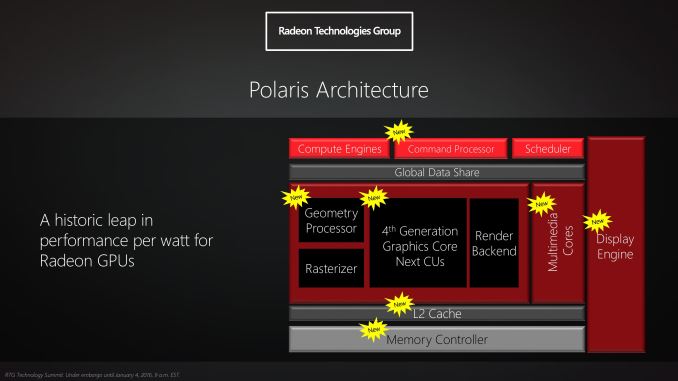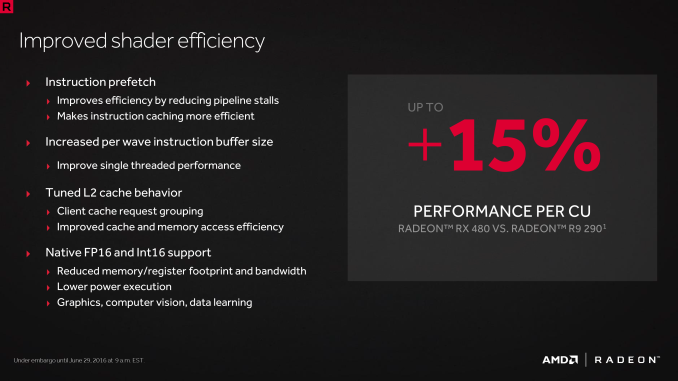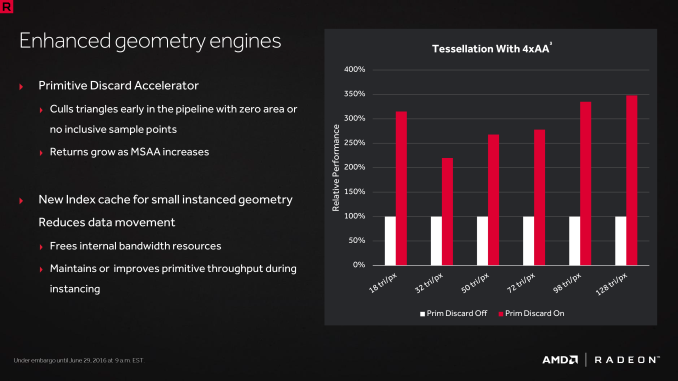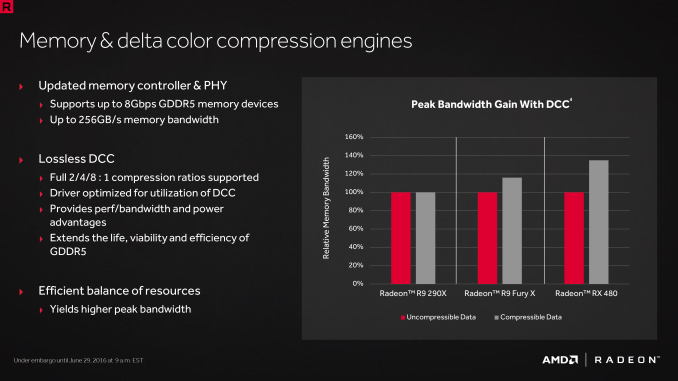The AMD Radeon RX 480 Preview: Polaris Makes Its Mainstream Mark
by Ryan Smith on June 29, 2016 9:00 AM ESTThe Polaris Architecture: In Brief
For today’s preview I’m going to quickly hit the highlights of the Polaris architecture.
In their announcement of the architecture this year, AMD laid out a basic overview of what components of the GPU would see major updates with Polaris. Polaris is not a complete overhaul of past AMD designs, but AMD has combined targeted performance upgrades with a chip-wide energy efficiency upgrade. As a result Polaris is a mix of old and new, and a lot more efficient in the process.
At its heart, Polaris is based on AMD’s 4th generation Graphics Core Next architecture (GCN 4). GCN 4 is not significantly different than GCN 1.2 (Tonga/Fiji), and in fact GCN 4’s ISA is identical to that of GCN 1.2’s. So everything we see here today comes not from broad, architectural changes, but from low-level microarchitectural changes that improve how instructions execute under the hood.
Overall AMD is claiming that GCN 4 (via RX 480) offers a 15% improvement in shader efficiency over GCN 1.1 (R9 290). This comes from two changes; instruction prefetching and a larger instruction buffer. In the case of the former, GCN 4 can, with the driver’s assistance, attempt to pre-fetch future instructions, something GCN 1.x could not do. When done correctly, this reduces/eliminates the need for a wave to stall to wait on an instruction fetch, keeping the CU fed and active more often. Meanwhile the per-wave instruction buffer (which is separate from the register file) has been increased from 12 DWORDs to 16 DWORDs, allowing more instructions to be buffered and, according to AMD, improving single-threaded performance.
Outside of the shader cores themselves, AMD has also made enhancements to the graphics front-end for Polaris. AMD’s latest architecture integrates what AMD calls a Primative Discard Accelerator. True to its name, the job of the discard accelerator is to remove (cull) triangles that are too small to be used, and to do so early enough in the rendering pipeline that the rest of the GPU is spared from having to deal with these unnecessary triangles. Degenerate triangles are culled before they even hit the vertex shader, while small triangles culled a bit later, after the vertex shader but before they hit the rasterizer. There’s no visual quality impact to this (only triangles that can’t be seen/rendered are culled), and as claimed by AMD, the benefits of the discard accelerator increase with MSAA levels, as MSAA otherwise exacerbates the small triangle problem.
Along these lines, Polaris also implements a new index cache, again meant to improve geometry performance. The index cache is designed specifically to accelerate geometry instancing performance, allowing small instanced geometry to stay close by in the cache, avoiding the power and bandwidth costs of shuffling this data around to other caches and VRAM.
Finally, at the back-end of the GPU, the ROP/L2/Memory controller partitions have also received their own updates. Chief among these is that Polaris implements the next generation of AMD’s delta color compression technology, which uses pattern matching to reduce the size and resulting memory bandwidth needs of frame buffers and render targets. As a result of this compression, color compression results in a de facto increase in available memory bandwidth and decrease in power consumption, at least so long as buffer is compressible. With Polaris, AMD supports a larger pattern library to better compress more buffers more often, improving on GCN 1.2 color compression by around 17%.
Otherwise we’ve already covered the increased L2 cache size, which is now at 2MB. Paired with this is AMD’s latest generation memory controller, which can now officially go to 8Gbps, and even a bit more than that when oveclocking.














449 Comments
View All Comments
AntDX316 - Thursday, June 30, 2016 - link
NVidia was talking about releasing the 1080 GTX for laptop instead of 1080M because they were scared AMD was going to come out big.The hope for massive gains are a lower expected price point is gone and the money milking will continue.
sonicmerlin - Friday, July 1, 2016 - link
AMD has again ceded the entire laptop market to Nvidia thanks to these horribly inefficient cards.medi03 - Thursday, June 30, 2016 - link
Comparing it to different tier card of current gen is childish or plain stupid, if coming from grown up.Performance is right on track.
Power consumption is disappointing, although not a problem for this tier.
I'm curios what it is caused by, could well be Samsung 14nm vs Glofo 16nm. I recall Apple's chips from Samsung were consuming more power than from TSMC, despite that one would expect it to be other way round.
cocochanel - Thursday, June 30, 2016 - link
In what world do you live ? Here in Canada, the Nvidia GTX 1080 sells for over 900 dollars Canadian !! The GTX 1070 is over 600 dollars. An RX480 with 8 Gigs of RAM it's about 300 dollars.I'll get one for Christmas and that leaves me plenty of change to buy an Oculus Rift set. How is that such a F-up ?
The stupidity on your behalf is astounding.
cocochanel - Thursday, June 30, 2016 - link
RX480 + Oculus Rift Set = GTX1080. Pricewise. That's a good F-up for me. Christmas is looking good.steamerSama - Thursday, June 30, 2016 - link
Many people have this twisted expectation. That a 200$ card will outperform something twice its cost is ridiculous. AMD has made a blunder, yes, by not releasing their flagship 490 first and come up with economy class 480. But other than that, if you were expecting a better performance than this, you were perhaps being sucked in by the hypeloguerto - Wednesday, June 29, 2016 - link
Let's see how all of this nice stuff transforms into performance ...rtho782 - Wednesday, June 29, 2016 - link
I think at this point I'd be more shocked had you posted a full review ;)So we're now waiting on GTX 960, GTX 1080/70, and RX 480....
justaviking - Wednesday, June 29, 2016 - link
We now have TWO QUESTIONS to ask every time a new GPU comes out:1) Can it play Crysis?
2) Where is the full GTX 1080 review?
Ryan Smith - Wednesday, June 29, 2016 - link
"2) Where is the full GTX 1080 review?"The full RX 480 review will be in a few days. The full GTX 1080 review will be a couple of days after that. RX 480 would have been a full review today, but I managed to slice myself with the RX 480 on Tuesday and needed to resolve that first...